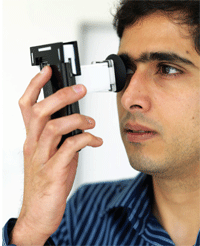What if you could measure refractive error with your cell phone? A research team at MIT has come up with a quick, simple and extremely cheap way to do just that. And it’s a method, they say, that’s especially suitable for remote, developing-world areas where eye doctors and auto-refractors are hard to come by.

The user places the NETRA device up to the eye, and using phone’s keypad, aligns patterns in the viewfinder.
But could this same do-it-yourself ‘eyePhone’ make optometrists obsolete?
Called NETRA (Near-Eye Tool for Refractive Assessment), the device includes a small plastic eyepiece clipped to a smartphone that is loaded with the NETRA software. The device measures refraction adapted from Shack-Hartmann wavefront aberrometry.
Specifically, the patient looks through the eyepiece to the LCD display, and presses the phone’s arrow keys until sets of parallel green and red lines just overlap. The patient repeats this eight times, with the lines at different angles, for each eye. The whole process takes less than two minutes, at which point software loaded onto the phone provides the prescription data.
“Our device has the potential to make routine refractive eye exams simpler and cheaper, and therefore more accessible to millions of people in developing countries,” says Manuel Oliveira, Ph.D., visiting associate professor at the MIT Media Lab and one of the NETRA developers.
“NETRA’s use of the smartphone gives this idea tremendous portability and scalability to reach remote areas where there are no eyecare providers,” says Greg Pearl, O.D., president of VOSH/International. “This device, in the hands of a locally-trained vision technician and coupled with some recent advancements in producing affordable prescription eyeglasses on the spot, will go far in achieving the VISION 2020 goal of providing all of mankind with affordable eyecare by the year 2020.”
“An inexpensive, portable and accurate autorefractor would be a great addition to the toolkits of visiting teams,” says Christine Mary Smith, R.N., O.D., F.V.I., president of the Delaware Valley VOSH chapter. However, she adds, “The biggest challenge on outreach trips today is to provide low-cost, accurate, functional, comfortable and attractive glasses for every patient.”
Says Brian Chou, O.D., co-developer of EyeXam iPhone app, “If the MIT technology is what it’s cracked up to be, it could be a game changer for our industry … To determine a glasses Rx with equivalent accuracy/precision as an optometrist’s refraction at a fraction of the cost would truly be remarkable.”
Some optometrists might be threatened by this technology, Dr. Chou says. Others, such as he, would embrace it. “I would love nothing more to have refraction delegated to a technician—or better yet, delegated to the patient for self-administration. That would free up my time for doing what only I can do, which is making diagnoses and treatment plans, and giving me more time to advise patients.”
Even the NETRA developers, on the FAQ page, pose the question: Does NETRA replace optometrists?
“No,” they write, “The goal of NETRA is to empower people, not replace optometrists. We expect the self-awareness will encourage more people to visit an optometrist where available.”
Rather, “Our device can be thought of as a thermometer for visual performance,” the MIT team writes. “Just as a thermometer measures corporal temperature and does not prescribe medicine, NETRA measures the refractive error and does not necessarily prescribe glasses. NETRA allows a user to self-assess the performance of her eye over time.”
Meantime, the group plans to launch production of the device as a for-profit company called PerfectSight, initially targeting parts of Africa and Asia. Ultimately, they also hope to produce a more advanced version that can incorporate its own higher-resolution display and be able to detect other conditions, such as cataracts, which could be sold in the developed world as well.
Pamplona VF, Mohan A, Oliveira MM, Raskar R. NETRA: Interactive display for estimating refractive errors and focal range. Proc of SIGGRAPH. 2010 July; 29(4):[epub ahead of print]

